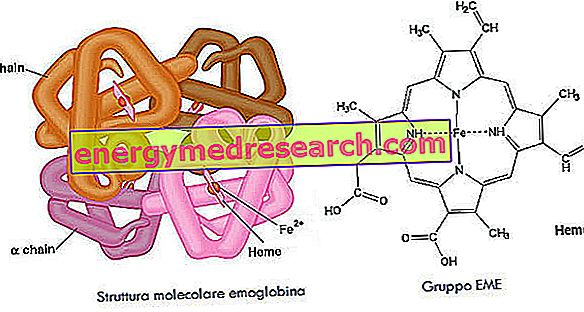Structure and functions
Hemoglobin is a metalloprotein contained in red blood cells, responsible for transporting oxygen in the blood stream. In fact, oxygen is only moderately soluble in water; therefore, the quantities dissolved in the blood (less than 2% of the total) are not sufficient to satisfy the metabolic demands of the tissues. The need for a specific carrier is therefore evident.
In the circulatory stream, oxygen cannot bind directly and reversibly to proteins, as is the case for metals such as copper and iron. Not surprisingly, at the center of each protein subunit of hemoglobin, wrapped in a protein shell, we find the so-called prosthetic group EME, with a metallic heart represented by an iron atom in the oxidation state Fe2 + (reduced state), which binds oxygen reversibly.
Blood analysis
- Normal hemoglobin values in the blood: 13-17 g / 100 ml
In women the values are on average 5-10% lower than in men.
Possible causes of High Hemoglobin
- Polycythemia
- Extended stay in height
- Chronic pulmonary diseases
- Heart disease
- Blood doping (use of erythropoietin and derivatives or substances that mimic its action)
Possible causes of low hemoglobin
- anemia
- Iron deficiency (sideropenia)
- Copious bleeding
- carcinomas
- Pregnancy
- thalassemia
- Burns
The oxygen content in the blood is therefore given by the sum of the small amount dissolved in the plasma with the fraction bound to the hemoglobinic iron.
More than 98% of the oxygen present in the blood is linked to hemoglobin, which in turn circulates in the blood stream allocated within the red blood cells. Thus, without hemoglobin, the erythrocytes could not fulfill their function of carrying oxygen in the blood.
Considering the central role of this metal, the synthesis of hemoglobin requires an adequate intake of iron with the diet. About 70% of the iron in the body is in fact enclosed in the EME groups of hemoglobin.
Hemoglobin consists of 4 subunits structurally very similar to myoglobin *.

Hemoglobin is a large and complex metalloprotein, characterized by four globular protein chains wrapped around an EME group containing Fe2 +.
For each hemoglobin molecule we find therefore four EME groups wrapped by the relative globular protein chain. Since in each hemoglobin molecule there are four iron atoms, each hemoglobin molecule can bind to itself four oxygen atoms, according to the reversible reaction:
Hb + 4O 2 ← → Hb (O 2 ) 4
As is known to most people, the task of hemoglobin is to take oxygen from the lungs, release it to the cells that need it, take carbon dioxide from them and release it into the lungs where the phyto begins again.
During the passage of blood in the capillaries of the pulmonary alveoli, the hemoglobin binds oxygen to itself, which subsequently yields to the tissues in the peripheral circulation. This exchange takes place because the bonds of oxygen with the EME group iron are labile and sensitive to many factors, the most important of which is the tension or partial pressure of oxygen.
Oxygen binding to hemoglobin and Bohr effect
In the lungs, the plasma oxygen tension increases due to the diffusion of the gas from the alveoli to the blood (↑ PO2); this increase causes hemoglobin to eagerly bind to oxygen; the opposite occurs in peripheral tissues, where the concentration of dissolved oxygen in the blood decreases (↓ PO2) and increases the partial pressure of carbon dioxide (↑ CO2); this causes hemoglobin to release oxygen by charging itself with CO2. By simplifying the concept to the maximum, more carbon dioxide is present in the blood and less oxygen remains tied to hemoglobin .
Although the amount of physically dissolved oxygen in the blood is very low, it therefore plays a fundamental role. In fact, this quantity heavily influences the bond strength between oxygen and hemoglobin (in addition to representing an important reference value in regulating pulmonary ventilation).
Summarizing the whole with a graph, the quantity of oxygen linked to hemoglobin increases in relation to the pO2 following a sigmoid curve:

The fact that the plateu region is so large places an important safety margin at the maximum saturation of hemoglobin during the passage in the lungs. Although the pO2 at the alveolar level is normally equal to 100 mm Hg, observing the figure we note in fact also as a partial pressure of oxygen equal to 70 mmHg (typical occurrence of some diseases or permanence at high altitude), the percentages of saturated hemoglobin remain close to 100%.
In the region of maximum slope, when the partial tension of oxygen falls below 40 mmHg, the ability of hemoglobin to bind oxygen drops abruptly.
In resting conditions, PO2 in intracellular fluids is approximately 40 mmHg; in this context, due to the gas laws, the oxygen dissolved in the plasma diffuses towards the tissues poorer than O2 by crossing the capillary membrane. Consequently, the plasma tension of O2 drops further and this favors the release of oxygen from hemoglobin. During an intense physical effort, on the other hand, the oxygen tension in the tissues drops to 15 mmHg or less, so the blood is strongly depleted of oxygen.
For what said, in rest conditions an important quantity of oxygenated hemoglobin leaves the tissues, remaining available in case of need (for example to face a sudden increase of the metabolism in some cells).
The continuous line shown in the image above is called the hemoglobin dissociation curve; it is typically determined in vitro at pH 7.4 and at a temperature of 37 ° C.
The Bohr effect has consequences both on the intake of O2 at the lung level and on its release at the tissue level.
Where there is more dissolved carbon dioxide in the form of bicarbonate the hemoglobin releases oxygen more easily and is charged with carbon dioxide (in the form of bicarbonate).

The same effect is obtained by acidifying the blood: the more the blood pH decreases and the less oxygen remains tied to hemoglobin; not by chance, in the blood the carbon dioxide is found dissolved mainly in the form of carbonic acid, which dissociates.



In honor of its discoverer, the effect of pH or carbon dioxide on oxygen dissociation is known as the Bohr effect.
As anticipated, in an acidic environment the hemoglobin releases oxygen more easily, while in a basic environment the bond with oxygen is stronger.

Among other factors capable of modifying the affinity of hemoglobin for oxygen we recall the temperature. In particular, the affinity of hemoglobin for oxygen decreases with increasing body temperature. This is particularly advantageous during the winter and spring months, since the temperature of the pulmonary blood (in contact with the air of the external environment) is lower than that reached at the level of the tissues, where the release of oxygen is therefore facilitated .

2, 3 diphosphoglycerate is an intermediate of glycolysis which influences the affinity of hemoglobin for oxygen. If its concentrations within the red blood cell increase, the affinity of the hemoglobin for oxygen decreases, thus facilitating the release of oxygen to the tissues. Not by chance, the erythrocyte concentrations of 2, 3 diphosphoglycerate increase, for example, in anemia, in cardio-pulmonary insufficiency and during the stay in high ground.
In general, the effect of 2, 3 bisphosphoglycerate is relatively slow, especially when compared to the rapid response to changes in pH, temperature and partial pressure of carbon dioxide.

The Bohr effect is very important during intense muscular work; in similar conditions, in fact, in the tissues most exposed to stress there is a local increase in temperature and pressure of carbon dioxide, and therefore of blood acidity. As explained above, all this favors the transfer of oxygen to the tissues, moving the hemoglobin dissociation curve to the right.



